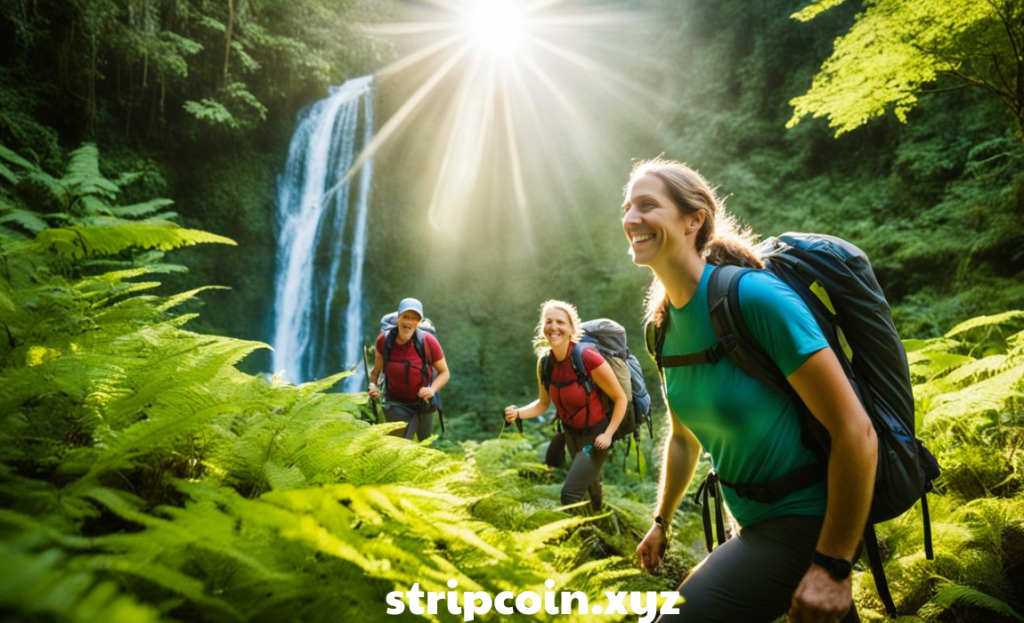Outdoor Activities
The Ultimate Guide to Nature Excursions: Exploring the Great Outdoors
Nature excursions offer the perfect escape from the hustle and bustle of daily life, allowing you to reconnect with the natural world. Whether you’re hiking through forests, exploring rugged coastlines, or embarking on wildlife safaris, nature excursions provide a unique blend of adventure, relaxation, and discovery.
For those seeking a deeper connection with the environment, planning a nature-focused getaway can offer both physical and mental rejuvenation. In this guide, we’ll explore the different types of nature excursions, the benefits of spending time outdoors, and tips for making the most of your next adventure into the wilderness.
1. What Are Nature Excursions?
Nature excursions are outdoor trips or experiences centered around exploring natural landscapes, ecosystems, and wildlife. These excursions can vary in duration, intensity, and location—from a leisurely nature walk through a local park to multi-day treks through remote wilderness areas. Designed to immerse participants in the natural world, these trips offer an opportunity to observe wildlife, engage in physical activity, and enjoy the beauty of untouched landscapes.
Common Types of Nature Excursions:
- Hiking and Trekking: Whether it’s a short day hike or a challenging multi-day trek, hiking allows you to explore diverse landscapes while getting in touch with nature.
- Wildlife Safaris: These excursions focus on observing animals in their natural habitats, often in national parks or wildlife reserves.
- Birdwatching: Birdwatching trips are designed for nature lovers looking to observe and identify bird species in their natural environments.
- Eco-Tours: Eco-tours emphasize sustainability and environmental education, often including guided tours of ecosystems like rainforests, wetlands, or coral reefs.
- Kayaking and Canoeing: Water-based excursions offer a unique perspective of nature as you navigate rivers, lakes, or coastal waters.
2. The Benefits of Nature Excursions
Spending time in nature has long been recognized for its positive effects on both mental and physical health. Nature excursions offer more than just an opportunity to explore the outdoors—they also provide a range of personal and environmental benefits.
1. Improved Physical Health
Most nature excursions involve physical activity, whether it’s hiking, paddling, or simply walking through scenic landscapes. These activities promote cardiovascular health, increase stamina, and improve overall fitness levels. The fresh air and outdoor environment also provide a welcome break from indoor exercise routines, making it easier to stay motivated and enjoy the benefits of being active.
2. Stress Relief and Mental Clarity
Nature has a calming effect on the mind, and spending time outdoors has been shown to reduce stress levels, lower blood pressure, and promote relaxation. The sounds of the forest, the sight of open landscapes, and the absence of urban distractions help clear the mind and provide mental clarity. Nature excursions also offer an opportunity to unplug from technology, encouraging mindfulness and a deeper connection to the present moment.
3. Increased Appreciation for the Environment
Nature excursions foster a greater appreciation for the environment and its ecosystems. Whether you’re exploring a national park, hiking through a forest, or observing wildlife, spending time in nature helps you better understand the importance of conservation and protecting our planet’s natural resources.
4. Bonding with Family and Friends
A nature excursion is a fantastic way to spend quality time with family and friends. Shared experiences in nature—whether it’s overcoming a challenging hike, spotting rare wildlife, or simply enjoying a scenic picnic—help build stronger relationships and create lasting memories.
3. Popular Types of Nature Excursions
There are countless ways to explore and enjoy the great outdoors. Here are some of the most popular types of nature excursions that appeal to adventurers, wildlife enthusiasts, and casual explorers alike.
1. Hiking and Backpacking Adventures
Hiking is one of the most accessible and popular ways to explore natural landscapes. Whether you’re embarking on a short trail in a local park or planning a multi-day backpacking trip through the mountains, hiking allows you to experience nature up close. Many hikers enjoy the challenge of reaching summits or waterfalls, while others prefer leisurely walks through forests or meadows.
Some of the world’s most famous hiking destinations include:
- The Inca Trail in Peru: A historic trek through the Andes Mountains leading to the ancient ruins of Machu Picchu.
- The Appalachian Trail in the U.S.: A scenic route that spans over 2,100 miles from Georgia to Maine, offering diverse landscapes.
- Torres del Paine in Chile: Known for its breathtaking views of jagged peaks, glaciers, and clear lakes.
2. Wildlife Safaris
For those interested in observing animals in their natural habitats, wildlife safaris offer an unforgettable experience. Safaris can take place in a range of environments, from African savannas to rainforests and wetlands. Participants can expect to see everything from lions and elephants to rare bird species and primates.
Top destinations for wildlife safaris include:
- Serengeti National Park in Tanzania: Famous for the Great Migration, where millions of wildebeest and zebras move across the plains.
- Kruger National Park in South Africa: Home to the “Big Five” (lion, elephant, rhino, leopard, and buffalo), Kruger offers a diverse range of wildlife sightings.
- Galápagos Islands in Ecuador: Known for its unique species like giant tortoises, marine iguanas, and blue-footed boobies, the Galápagos is a must-visit for wildlife enthusiasts.
3. Birdwatching Tours
Birdwatching is a peaceful and educational nature excursion that allows you to observe birds in their natural environments. Birdwatchers often travel to regions with diverse ecosystems to spot rare or migratory species. With a pair of binoculars and a field guide, birdwatchers can enjoy hours of peaceful observation.
Top birdwatching destinations include:
- Costa Rica: Home to over 900 bird species, including toucans, hummingbirds, and quetzals.
- Yellowstone National Park in the U.S.: Known for its diverse birdlife, including bald eagles, ospreys, and trumpeter swans.
- The Scottish Highlands: Offering sightings of golden eagles, red kites, and ptarmigans, the Highlands are a top destination for birdwatching enthusiasts.
4. Kayaking and Canoeing
Water-based nature excursions, such as kayaking and canoeing, allow you to explore rivers, lakes, and coastal regions from a unique vantage point. Paddling through calm waters provides a serene experience, and it’s not uncommon to encounter wildlife like dolphins, otters, or various bird species along the way.
Popular destinations for kayaking and canoeing include:
- The Norwegian Fjords: Paddle through stunning fjords surrounded by towering cliffs and glaciers.
- Lake Powell in the U.S.: Known for its dramatic red rock canyons and clear blue waters, this lake offers a peaceful and picturesque kayaking experience.
- The Amazon River: Explore one of the most biodiverse regions in the world, with opportunities to see exotic wildlife and lush rainforests.
4. Tips for Planning a Nature Excursion
To ensure a safe and enjoyable experience, careful planning is key when embarking on a nature excursion. Here are some tips to help you prepare for your outdoor adventure.
1. Choose the Right Location
Research the best destinations for the type of nature excursion you’re interested in, whether it’s hiking, wildlife viewing, or water-based activities. Consider factors such as weather, difficulty level, and accessibility when choosing your location.
2. Pack Appropriately
Proper gear is essential for a successful nature excursion. For hiking or trekking, bring sturdy shoes, comfortable clothing, and a well-stocked backpack with water, snacks, and a map or GPS. If you’re embarking on a wildlife safari or birdwatching trip, pack binoculars, a camera, and a wildlife guidebook. For water-based excursions, make sure to bring waterproof gear and personal flotation devices.
3. Follow Leave No Trace Principles
When enjoying the outdoors, it’s important to minimize your impact on the environment. Follow Leave No Trace principles by staying on designated trails, disposing of waste properly, and respecting wildlife. These practices help preserve the natural beauty of outdoor areas for future generations.
4. Hire a Guide for Specialized Tours
For more complex nature excursions, such as safaris or eco-tours, hiring a guide can enhance your experience. Expert guides can provide valuable insight into the local ecosystem, point out wildlife, and ensure your safety during the trip.
Conclusion
Nature excursions offer an extraordinary opportunity to explore the outdoors, connect with the environment, and experience the beauty of the natural world. Whether you’re hiking through forests, observing wildlife on a safari, or kayaking through tranquil waters, these outdoor adventures provide physical, mental, and emotional benefits that enrich your life.
By planning carefully and choosing the right type of excursion, you can embark on a rewarding adventure that not only satisfies your sense of exploration but also deepens your appreciation for the planet’s natural wonders.

